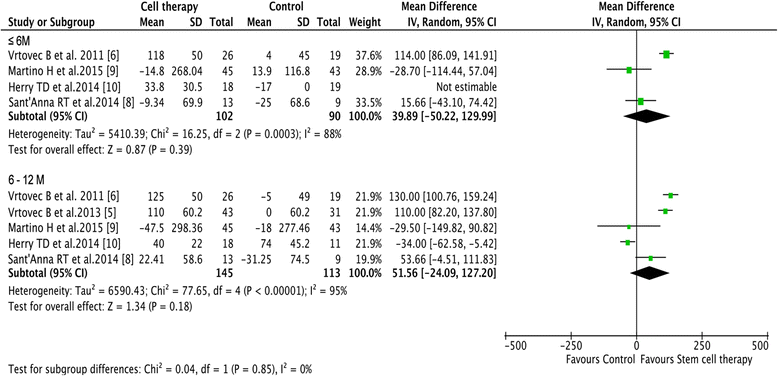A systematic review of randomised controlled trials examining the therapeutic effects of adult bone marrow-derived stem cells for non-ischaemic dilated cardiomyopathy
- PMID: 27938412
- PMCID: PMC5148892
- DOI: 10.1186/s13287-016-0441-x
A systematic review of randomised controlled trials examining the therapeutic effects of adult bone marrow-derived stem cells for non-ischaemic dilated cardiomyopathy
Abstract
Background: Certain early-phase clinical trials have suggested that bone marrow-derived stem cell transplantation might improve left ventricular function in patients with non-ischaemic dilated cardiomyopathy (NIDCM), whereas others trials have revealed no benefit from this approach. We sought to evaluate the therapeutic effects of bone marrow-derived stem cell therapy on NIDCM.
Methods: We searched the PubMed, Embase, and Cochrane Central Register of Controlled Trials (CENTRAL) databases (through February 2016) for randomised controlled clinical trials that reported on bone marrow-derived stem cell transplantation for patients with NIDCM with a follow-up period ≥12 months. The co-primary endpoints were changes in mortality rate and left ventricular ejection fraction (LVEF); the secondary endpoints were changes in the 6-minute-walk test (6MWT) and left ventricular chamber size. Seven trials involving bone marrow-derived stem cell therapy that included 482 patients satisfied the inclusion and exclusion criteria.
Results: Subjects who received bone marrow-derived stem cell therapy exhibited a significant reduction in mortality rate (19.7% in the cell group vs. 27.1% in the control group; 95% confidence interval (CI) -0.16 to -0.00, I 2 = 52%, p = 0.04). Bone marrow-derived stem cell therapy tended to produce LVEF improvement within 6 months (1.83% increase; 95% CI -0.27 to 3.94, I 2 = 74%, p = 0.09) and significantly improved LVEF after mid-term (6-12 months) follow-up (3.53% increase; 95% CI 0.76 to 6.29, I 2 = 88%, p = 0.01). However, this therapy produced no significant benefit in the 6MWT (p = 0.18). Finally, the transplantation of increased numbers of stem cells resulted in no observable additional benefit with respect to LVEF.
Conclusions: Bone marrow-derived stem cell therapy might have improved prognoses and appeared to provide moderate benefits in cardiac systolic function at mid-term follow-up. However, this therapy produced no observed improvement in exercise tolerance.
Keywords: Bone marrow-derived stem cell therapy; Cardiac systolic function; Follow-up; Mortality rate; Non-ischaemic dilated cardiomyopathy.
Figures




References
-
- Hunt SA, Abraham WT, Chin MH, Feldman AM, Francis GS, Ganiats TG, et al. Focused update incorporated into the ACC/AHA 2005 Guidelines for the Diagnosis and Management of Heart Failure in Adults. A Report of the American College of Cardiology Foundation/American Heart Association Task Force on Practice Guidelines developed in collaboration with the International Society for Heart and Lung Transplantation. J Am Coll Cardiol. 2009;2009(53):e1–90. doi: 10.1016/j.jacc.2008.11.013. - DOI - PubMed
-
- Lloyd-Jones D, Adams R, Carnethon M, De Simone G, Ferguson TB, Flegal K, et al. Heart disease and stroke statistics—2009 update: a report from the American Heart Association Statistics Committee and Stroke Statistics Subcommittee. Circulation. 2009;119:480–6. doi: 10.1161/CIRCULATIONAHA.108.191259. - DOI - PubMed
Publication types
MeSH terms
LinkOut - more resources
Full Text Sources
Other Literature Sources

